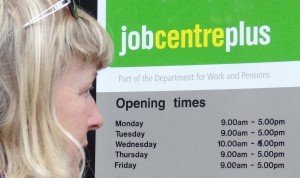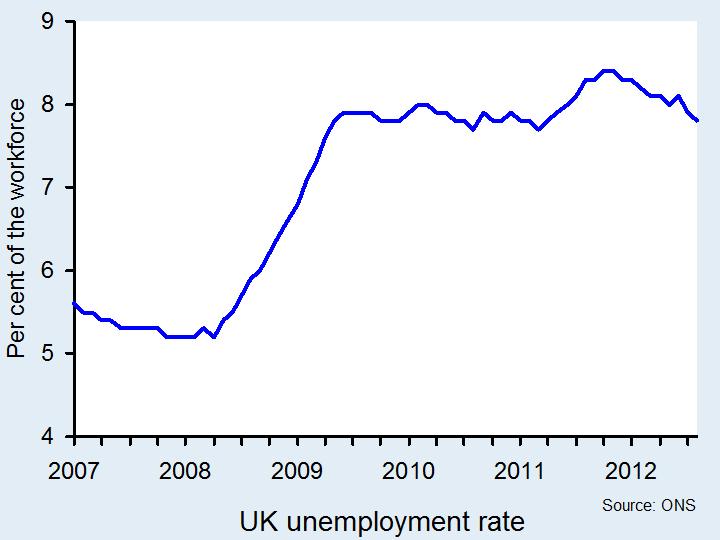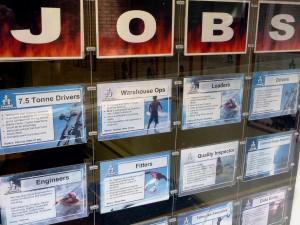 UK Unemployment figures for the July to September period have just been published. Perhaps surprisingly, the rate has fallen to 7.8% from 8.0% in the previous 3-month period. What is more, there have been similar 0.2 percentage-point falls in each of the two 3-month periods prior to that (see chart below).
UK Unemployment figures for the July to September period have just been published. Perhaps surprisingly, the rate has fallen to 7.8% from 8.0% in the previous 3-month period. What is more, there have been similar 0.2 percentage-point falls in each of the two 3-month periods prior to that (see chart below).
This would normally suggest that the economy has been growing strongly and faster than the growth in potential output. But, despite positive economic growth in quarter 3 (see A positive turn of events?), the economy has been experiencing a prolonged period of low or negative growth.

So what is the explanation for the fall in unemployment? (For a PowerPoint of the chart, click here)
One reason is a greater flexibility in the labour market than in previous recessions. People are more willing to accept below inflation wage increases, or even nominal wage cuts, in return for greater job security. Others are prepared to reduce their hours.
The other reason is a fall in productivity (i.e. output per hour worked). One explanation is that people are not working so hard because, with a lack of demand, there is less pressure on them to be productive; a similar explanation is that firms are ‘hoarding’ labour in the hope that the market will pick up again.

Another explanation is that employment growth has often occurred in the low productivity industries, such as labour-intensive service industries; another is that when people leave their jobs they are replace by less productive workers on lower wages; another is that workers are making do with ageing equipment, whose productivity is falling, because firms cannot afford to invest in new equipment. An range of possible explanations is given on page 33 of the Bank of England’s November 2012 Inflation Report.
But with many predicting that growth will be negative again in 2012 quarter 4, the fall in unemployment may not continue. Britain may join many other countries in Europe and experience rising unemployment as well as falling output.
Articles
Government hails fall in jobless total The Guardian, Hélène Mulholland (14/11/12)
UK unemployment figures: analysis The Guardian, Larry Elliott (14/11/12)
Jobless claims rise as Olympics effect wanes The Telegraph, Rachel Cooper and Louisa Peacock (14/11/12)
UK unemployment falls to 2.51 million, ONS says BBC News (14/11/12)
 Unemployment continuing to fall BBC News, Stephanie Flanders (14/11/12)
Unemployment continuing to fall BBC News, Stephanie Flanders (14/11/12)
Britain’s recession: Harsh but fair? BBC News, Stephanie Flanders (17/10/12)
The UK productivity puzzle (cont’d) BBC News, Stephanie Flanders (20/9/12)
UK jobs: The plot thickens BBC News, Stephanie Flanders (15/8/12)
Data
Unemployment: the key UK data and benefit claimants for every constituency Guardian Data Blog
Labour Market Statistics, November 2012 ONS
 Video Summary: Latest on the Labour Market, November 2012 ONS
Video Summary: Latest on the Labour Market, November 2012 ONS
Labour Productivity, Q2 2012 ONS
International Comparisons of Productivity, First estimates for 2011 ONS
Questions
- What possible explanation are there for the latest fall in unemployment?
- What has been happening to employment, both full time and part time?
- What are the different ways of measuring productivity? Why will they be affected differently by a fall in the average number of hours worked?
- Why might it be in firms’ interests to maintain the level of their workforce despite falling sales?
- Assume that there has been a fall in aggregate demand. Compare the resulting effect on consumption of (a) a fall in wages rates; (b) a rise in unemployment. How might the design of the benefit system affect the answer?
Over recent years, labour markets have become more flexible. Both firms and workers have been much more adaptable to changing market conditions.
This has been illustrated by responses to the 2008/9 recession and the minimal recovery since then. Many firms have seen a drop in demand for their products and have responded by producing less. But this has not necessarily meant laying off workers. But why not? The following include some of the reasons:
• greater flexibility in hours worked: thus hours can be reduced;
• reduction in real wages because of wages not keeping up with inflation;
• many workers receiving part of their income in the form of profit sharing: when profits fall, employees’ income automatically falls;
• a general reduction in unionisation in the private sector;
• in firms where workers are still unionised, unions and management increasingly seeing themselves to be on the ‘same side’: thus unions more willing to explore flexibility;
• less support from state if people are unemployed;
• greater flexibility from the use of temporary or agency staff: these can be reduced in a recession, thus helping to protect the jobs of established workers.
The following podcast looks at this growing flexibility and why it has helped to restrict the rise in unemployment.
Podcast
 The real economy: Labour market BBC Today Programme, Evan Davis (24/8/11)
The real economy: Labour market BBC Today Programme, Evan Davis (24/8/11)
Articles
Agencies placing more in new jobs Western Mail (4/8/11)
Staff appointments increase at subdued pace in July, according to latest Report on Jobs The Recruitment & Employment Federation, News Release (4/8/11)
Manufacturing week: How we got here The Telegraph, Roland Gribben (27/8/11)
Jobless figures show the real risk of creating a lost generation London Evening Standard, Jonathan Portes, Director, National Institute of Economic and Social Research (17/8/11)
Flexible working: is more legislation needed? Personnel Today, Laura Chamberlain (1/9/11)
Recruitment agencies ‘play a big part’ in flexible working The Sales Director, John Oak (10/8/11)
Questions
- Find out what has happened to real GDP, employment and unemployment over the past four years. (Try searching Reference Tables for GDP and Labour Market Statistics on the National Statistics site at http://www.ons.gov.uk/ons/datasets-and-tables/index.html.)
- Distinguish between ‘insiders’ and ‘outsiders’ in the labour market? How has the relationship between the two groups changed in recent years?
- Distinguish between functional, numerical and financial flexibility of firms? (See Box 9.8 in Economics (7th ed), Web Case 6.2 in Essentials of Economics (5th ed), section 18.7 in Economics for Business (5th ed) or section 8.5 in Economics and the Business Environment (3rd ed).)
- Examine the effects of wage rises being less than the rate of inflation on the profit-maximising number of full-time equivalent people employed. How is this influenced by the rate of increase in the price of other inputs and the ability of the firm to raise prices in line with inflation?
- Should firms be required by law to allow workers to demand flexible working conditions? What forms might such flexibility take?
Bank rate in the UK has been at the historically low level of 0.5% since March 2009 and the MPC decision on 13 January was to leave the rate unchanged (see also). But inflation has been well above the Bank of England’s target of 2% since December 2009 and it could well rise further as international commodity prices are soaring. Some economists are thus arguing that Bank rate should rise. This is crucial, they say, to dampen inflationary expectations.
Other economists, however, argue that aggregate demand is likely to remain depressed and that the economy is operating with a large negative output gap. What is more, house prices are falling, as are real wages (see Bosses gain – workers’ pain)
In the following extract from BBC Radio 4’s Today Programme, two economists, Charles Goodhart and Willem Buiter, both former members of the MPC, debate the issue.
Podcast
 Should interest rates rise? BBC Today Programme (13/1/11)
Should interest rates rise? BBC Today Programme (13/1/11)
Data
Economic and Labour Market Review, Office for National Statistics (For inflation data see Tables Chapter 3, Table 3.01; for interest rates see Tables Chapter 5, Table 5.08)
Monetary Policy Committee Decisions Bank of England
Questions
- What are the arguments for a rise in Bank rate at the current time?
- What are the arguments against a rise in Bank rate at the current time?
- What information would you require to decide which of the arguments was the more powerful?
- Why is it difficult to decide the size of the output gap?
- To what extent do the arguments for and against a rise in Bank rate depend on the factors determining expectations, and what expectations are important here?
- To what extent are exchange rates relevant to the effectiveness of interest rate policy?
 UK Unemployment figures for the July to September period have just been published. Perhaps surprisingly, the rate has fallen to 7.8% from 8.0% in the previous 3-month period. What is more, there have been similar 0.2 percentage-point falls in each of the two 3-month periods prior to that (see chart below).
UK Unemployment figures for the July to September period have just been published. Perhaps surprisingly, the rate has fallen to 7.8% from 8.0% in the previous 3-month period. What is more, there have been similar 0.2 percentage-point falls in each of the two 3-month periods prior to that (see chart below). Unemployment continuing to fall BBC News, Stephanie Flanders (14/11/12)
Unemployment continuing to fall BBC News, Stephanie Flanders (14/11/12) Video Summary: Latest on the Labour Market, November 2012 ONS
Video Summary: Latest on the Labour Market, November 2012 ONS
